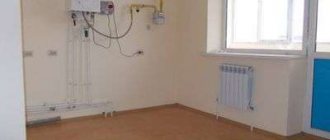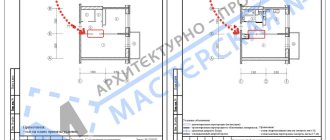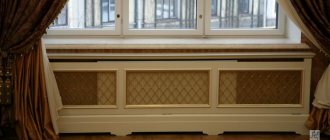What the law says
Issues of maintenance and repair, reconstruction and redevelopment of residential premises in an apartment building are regulated by the norms of the Housing Code (LC RF).
Relocating a battery is essentially a refurbishment of a living space that requires changes to the technical documentation.
Guided by the provisions of Art. 26 of the Housing Code of the Russian Federation, before you begin redevelopment of the heating system, changing the location of the radiators, you must obtain permission from local authorities.
Package of documents required for approval
First of all, you need to prepare a project specifying the types of equipment and installation locations.
The technical report must indicate the location of heating devices.
Important to note:
- for a thermal engineering calculation proving that heat losses will not increase as a result of the redevelopment;
- to maintain access to heating risers.
A written appeal is submitted in the prescribed form through the MFC or during a personal visit, attaching:
- the original or a notarized copy of the document confirming ownership of the apartment - purchase and sale agreement, exchange, donation, will;
- compliant refurbishment project;
- registration certificate for the apartment;
- written consent to the relocation of all adult family members living with the applicant at the specified address.
After completing the installation of the battery at a new location, a commission is invited to sign an acceptance certificate, which serves as the basis for making changes to the technical passport.
Responsibility for unauthorized transfer of battery
Since any changes to utilities without appropriate permission are a violation of the law, unauthorized transfer of the battery is fraught with:
- administrative punishment in the form of a fine of 2-2.5 thousand rubles (clause 2 of article 7.21 of the Code of Administrative Offenses of the Russian Federation);
- forced by a court decision to restore the premises to their previous condition, which will require additional material costs.
Main reasons for relocating batteries
- The room does not maintain the temperature required for comfortable living.
- The owners decided to carry out renovations, and the battery does not look good in the interior.
- The wall on which the battery was located was demolished.
- In the event that a loggia is connected to a room, creating a space that requires heating.
- All heating devices will be replaced with newer models.
- Existing batteries will be replaced with a different type of radiator.
Possible connection diagrams
In the loggia, the battery can be connected in three ways:
- With jumper and tap. An excellent solution for this room, because all the heat will pass through the radiator without any loss;
- With jumper, but without tap. The presence of a jumper allows you to close the flow of hot water when the air in the room gets too hot;
- Without jumper, but with tap. The presence of such a solution allows not only to shut off the flow of water, but also to temporarily dismantle the radiator to carry out the necessary work.
Removing the battery allows you to make a full-fledged room in the loggia for permanent residence or solving any other problems. Of course, everything must be coordinated with the housing inspection and other regulatory authorities.
If permission has not been obtained from the authorities, then as an alternative option you can consider installing a heated floor system, which is also ideal for loggias and balconies.
If possible, it is best to entrust the work to professionals who are familiar with the features of installing heating radiators and putting them into operation.
Is illegal installation possible?
Naturally, very often you can find cases where the removal of a heating radiator into the loggia is carried out without any approval. Moreover, all installation work is carried out independently, because many mechanics and craftsmen will definitely ask to see permits before starting the installation of a heating radiator. If they do not exist, then few specialists will engage in such work.
Illegal removal of a heating radiator onto a balcony is punishable by a fine. In accordance with the current Code of the Russian Federation on Administrative Offenses, the fine is several thousand rubles. In addition, it will be necessary to carry out work to dismantle the radiator and return everything to its place.
However, after the work has been completed, you can try to get started with paperwork and legalization of the redevelopment.
Although this is a complex process, such a development of events still has the right to life. If the apartment owner refuses to pay fines or remove the heating radiator from the loggia, then the housing company may take extreme measures - go to the courts.
Remember
Based on the results of an analysis of the provisions of the current legislation and established judicial practice, it can be concluded that, in general, the replacement of intra-apartment engineering systems is not a reconstruction and does not require prior approval from the Civil Housing Inspectorate.
However, if, as a result of such changes, the operation of the entire system as a whole is disrupted, then the management authority has the opportunity through the court to force the owners to eliminate these violations. At the same time, practice shows that in such cases the management organization often fails to prove the fact that interference in the operation of the systems led to negative consequences for the remaining owners.
If such a dispute is brewing, then first it is necessary to conduct an examination and understand how much the changes affect the intra-house system as a whole and what adverse consequences they can lead to. Formally, even if the owner, without the knowledge of the management authority, rearranges all the equipment inside the apartment, but at the same time he has an expert’s opinion in his hands that no one will suffer from this rearrangement, the court will side with the owner.
Stages of transferring radiators
- Contacting the management company or housing and communal services.
- Collecting necessary documents, obtaining permission.
- The process of dismantling and installation work.
- The arrival of the commission, which must provide written confirmation of the legality of the transfer of batteries.
Important : Do not under any circumstances move heating radiators to other rooms or add additional sections. Since all this can lead to penalties and the management company going to court.
Materials and tools
To build up heating radiators yourself, you will need some tools:
- Adjustable wrenches. Special radiator keys may also be suitable.
- Gaskets must be laid between sections. Therefore, it is necessary to purchase them in advance.
- Side plugs with gaskets.
- Nipples for cast iron radiators. Their number is equal to the number of sections.
Choosing a radiator
When the procedure for obtaining permission has been successfully completed, it is time to choose a room heating element that is suitable for the loggia.
All batteries are divided into 3 types:
- economy segment;
- middle class;
- premium
The main criteria for differences are cost, quality of materials and duration of operation.
Cast iron
The best and most durable metal of all times has been and remains cast iron. The shelf life of such radiators is more than 35 years. They are stronger than analogs made from other materials, but they weigh a lot. It is recommended to install it on the loggia only from the side of the house wall. The balcony can support no more than 600 kg of weight.
There is no need to additionally load it, because there is an installed double-glazed window, finishing, tiles on the floor (or other covering), and furniture. They look quite massive and the classic look does not always fit into a modern interior.
We recommend: General ventilation: classification of air exchange methods, principles of supply and exhaust movement
Aluminum
They weigh much less, are made in a modern design, and conduct heat well. The only negative: they can rust and deteriorate if the water they receive is of poor quality. Recommended for private homes where the source of water is known and autonomous.
Bimetal
Radiators of this type are most often used in apartment buildings. Bimetallic structures are compact and look laconic. They come in different sizes, conduct and release heat well. Ideal for a balcony or loggia due to its light weight and versatility in installation.
Is it possible to move the battery in the kitchen or room?
The correct decision when replacing a heating radiator is to select a new device with similar thermal characteristics. By observing this condition, you can move radiators in your apartment without fear that problems will arise for you or your neighbors during the heating season.
In addition, one of the conditions that you need to remember during repairs is to preserve access to the heating risers - if you plan to cover them with decorative boxes, they should be made easily removable (for example, fastened with magnets).
An example of a redevelopment project with battery relocation:
In the example given, the heating battery was removed from the partition between the kitchen (4) and the room (3), since this partition was demolished during the redevelopment. A floor-mounted convector of similar power was chosen as a heating device.
The location of heating devices is indicated in the technical report, and in the redevelopment project all construction measures and technologies used are described in detail, including the item on moving or replacing the heating battery.
Changes in intra-apartment networks should not violate the rights and interests of citizens
Changes made by the owner of the premises to the utility networks inside the apartment can be saved only if they do not violate the rights and legitimate interests of citizens and do not pose a threat to their life and health.
In particular, the law does not allow redevelopment of apartments that leads to a violation of the strength or destruction of the building’s load-bearing structures, disruption of the operation of engineering systems or equipment, deterioration of the safety and appearance of facades, or damage to fire-fighting devices.
Moreover, when replacing any elements of an engineering system, care should be taken to ensure that the newly installed equipment is identical in its technical parameters. For example, if pipelines of a smaller diameter are installed, this may lead to disruption of the circulation of resources through the system, which may negatively affect the operation of networks in other apartments.
Under such circumstances, there is a high probability that the court will also oblige the owner to bring the system into compliance with the project. A similar practice has developed both in Arbitration Courts, for example, case No. A59-4317/2013, and in courts of general jurisdiction, for example, the decision of the Leninsky District Court of Vladimir dated June 10, 2019 in case No. 2-2866/2018 and the decision of the Dimitrovgrad City Court of the Ulyanovsk Region dated January 29, 2019 in case No. 2-2842/2018.
Relocating the battery to a balcony or loggia - can this be agreed upon?
One of the factors determining the admissibility of redevelopment is maintaining the level of heat loss by the building (preserving the thermal contour).
We are often asked whether it is possible to move the battery to a balcony or loggia, provided that glazing and thermal insulation are installed there?
In Moscow, moving the battery to a balcony or loggia is prohibited by clause 10.7 of City Government Resolution No. 508-PP, and in the Moscow region - by local regulations.
In this case, the presence of glazing and thermal insulation does not matter at all, since balconies and loggias are summer rooms for which heating is not provided.
Therefore, moving the battery to a balcony or loggia cannot be agreed upon. In addition to a fine, the owner of an apartment with such a violation risks receiving an order and having to move the heating battery back at his own expense.
At the same time, current legislation does not prohibit the use of electric heating devices to maintain the required temperature on a glazed balcony (loggia). It is important that their energy consumption does not lead to exceeding the power allocated to the apartment.
Often, during redevelopment, the window sill block between the balcony (loggia) and the room (kitchen) is dismantled in order to combine the rooms.
Current regulations prohibit combining rooms directly - the redevelopment project requires the provision of French glazing in the form of translucent doors of at least double glazing, which is installed between the rooms instead of the demolished section of the wall.
Such redevelopment requires the inclusion of a thermal engineering calculation in the project, confirming that heat losses will not increase after the renovation.
If you are going to do redevelopment, we are ready to help you with this. Our organization has been developing project documentation and its coordination with all government authorities for many years.
Our company’s specialists will answer all your questions and help you decide on possible options for changing the layout of your apartment.
From us you can order a redevelopment project and a technical report, as well as a service for coordinating turnkey repair work
Coordination of battery replacement
Heating in a private house and in an apartment are two big differences, from the point of view of dependence on city services and organizations that have the authority to authorize influence on the housing heating system.
If the owners of their own private houses can boast of complete independence from architectural organizations, as well as housing and communal services, then the owners of comfortable residential areas are somewhat dependent.
All actions related to the transfer of walls, as well as the modernization of the internal heating circuit of the apartment, require documentary approval from the specified city organizations.
Legal aspects of modernizing heating distribution
Coordination of battery replacement
This issue concerns houses under the jurisdiction of city communal structures. Any intervention by the homeowner in the modernization of the heating system is a potential violation of the technical conditions of their operation.
For this reason, in order to avoid unpleasant incidents with public utilities, it is necessary to obtain documented support from housing and communal services for the redevelopment of pipe distribution in the residential space.
Otherwise, a fine is inevitable.
Prohibitions when moving a heating battery
Not all options for moving the radiator of a home heating system can be done legally.
to remove a heating device, or install an additional one on a balcony or loggia, connected to the heating system of the house .
In this case, no one will look at the fact that the glazing has been installed and insulation has been completed - it is very possible to receive a fine, or even a lawsuit. In any case, the heating system will have to be restored to its original form.
When is the best time to extend radiators?
The time it takes to build up radiators depends on the material from which the device is made. If the battery is made of cast iron, then expansion can be done after the end of the heating season. This is due to the fact that sections can be increased after complete disassembly of the cast iron battery. Naturally, in winter there is no way to turn off the heating system and disassemble the radiators. Moreover, if you live in a multi-storey building, it is unlikely that your neighbors will agree to be left without heating. Therefore, radiator sections can be expanded only after the end of the heating season.
Preparation for installation
Preparatory activities include several mandatory steps.
Radiator selection
You need to choose the type of radiator based on its technical characteristics , the most important of which is operating pressure. It must comply with the pressure drop limits in the heating system of the house. As a rule, in old five-story buildings the value of this indicator is 6–8 atmospheres, and in multi-story buildings (10–14 floors) the pressure level reaches 12–15 atmospheres.
The second important indicator is resistance to water hammer . The service life of the radiator and the quality of heating depend on this characteristic. With a centralized heating system, it is almost impossible to avoid water hammer, so when choosing equipment you need to pay attention to this technical characteristic. Additional important factors include lifespan, ease of installation, and heatsink design.
Types of radiators
Types of batteries and radiators are divided according to classes and materials of manufacture:
- Cast iron. They have the longest service life (up to 35 years). The main disadvantage is the long heating and cooling time.
- Steel panel. They will last about 15 years. They are valued for their high heat transfer rates and other technical characteristics, as well as their low cost.
- Tubular steel. They are available in a variety of colors and designs, allowing you to match them to any interior. They have excellent consumer properties. The disadvantages include high cost.
- Aluminum. Average service life is 15 – 20 years. They are characterized by high thermal conductivity and low weight. The main disadvantage is the sensitivity of the filler to the PH, therefore they are recommended for private houses with an autonomous heating system.
- Bimetallic. The best option for an apartment, as they are unpretentious in terms of the composition and quality of water, have good heat transfer, and are resistant to water hammer.
We recommend: What are thermal bridges?
Calculation of the number of sections
All types of radiators are composite, so you can select the number of sections needed to heat a particular room, depending on the area.
The calculation must be made on the basis of generally accepted standards:
- one aluminum section per 2 m2;
- one bimetallic section per 1.5 m2;
- add 1-2 sections for reinsurance.
Selecting a connection option
You can consider the following connection methods:
- Side. The most common installation method. The inlet and outlet pipes are mounted on one side of the radiator. The main requirement is to maintain the distance between the fittings, otherwise the radiator will not warm up sufficiently.
- Lower. With this option, both pipes are mounted at the bottom of the radiator - inlet on one side, outlet on the other. The main disadvantage is low heat transfer.
- Diagonal. The input is mounted on top on one side of the radiator, and the output is mounted on the bottom on the other. With this method, the least heat loss is achieved, so it is considered the best.
Which pipes to choose
For work , it is recommended to choose reinforced polypropylene pipes because they :
- easy to bend, allowing installation of any complexity;
- do not deform during operation;
- do not require welding - flux is applied to the joints and sealed with a special blowtorch;
- have a high heat transfer coefficient.
It is possible to use copper pipes, but this is a more expensive and difficult to install option. Ordinary propylene quickly deforms and loses its attractive appearance.
Why is coolant in the system in summer?
It sounds quite paradoxical, but steel and cast iron elements of heating systems are damaged by rust to a lesser extent when there is coolant inside. Why is this happening?
The answer lies in the following reasons:
- Water or other coolant in the heating system (meaning a closed heating system) is located inside a closed volume. In this case, the internal cavities do not communicate with atmospheric air. Corrosion occurs when dissolved oxygen in water comes into contact with metal inside the network,
Photo of a cut heating pipe with corrosion
- Due to the fact that the system is cut off from the environment, water (or other coolant) quickly loses dissolved oxygen, because it will completely react with the iron atoms inside the pipes and batteries. After this, the oxidation process stops, because there is no free dissolved oxygen left in the coolant and the heating system ceases to corrode,
- Thus, the heating system from the inside practically does not rust, unlike pipelines for hot and cold water. If the coolant is removed from the network, then moist air remains inside, which contains about 20% oxygen. Therefore, when there is no water inside the network, steel and cast iron elements are subject to rust.
Installation of a heating system on the balcony
Work of this kind is carried out in the summer, when the heating is turned off.
It is quite difficult to move a heating radiator to a balcony or loggia on your own; it is better to entrust this process to professional plumbers. Those who decide to make do on their own need to use the following materials and tools:
- Mayevsky crane;
- shut-off and control valves;
- plugs;
- foot nuts;
- tape measure;
- grinder;
- pipes;
- hammer drill;
- vice;
- die;
- welding machine;
- sealant.
Initially, a diagram is developed according to which the connection will be made. In any case, a jumper must be used. It will prevent problems with neighbors, even if the installation is carried out with the heating system on.
Stages of work
Instructions:
- Installation is carried out to the main heating pipe. To do this, a cut is made with a grinder. Afterwards, the external threads on the pipes are cut and fastened. A branched fitting is used for connection. Important: when connecting pipes and parts, waterproofing must be used. This could be tow or fum tape.
- First, holes are drilled in the wall using a hammer drill, through which the pipes are pulled. There should be a thread on the outside of them. If the radiator is located on the wall of the house, then the pipes should extend to a distance of up to 10 cm. If on the side wall of the balcony, then they must be extended further, turning them using fittings.
- In the place that was planned for placing the battery on the balcony, one pipe with an angle fitting is placed vertically.
Next the radiator is hung.
Radiator installation
The first step is to prepare the mounting location. It is recommended to install foil or similar heat-reflecting material on the wall so that the heating works inside the room and not on the walls.
- Fixation points are outlined. Brackets are installed on them. If the heating radiator is cast iron, then they must be anchored and reinforced.
- Installation of fastening systems is carried out using a hammer drill; the walls must be fully prepared.
- The radiator is hung on the fixing elements. Installation is carried out using bolts and nuts, rubber washers are installed for structural reliability.
- The uniform position is checked using a building level.
- The eyeliner is connected. To do this, 2 pipes (25-30 cm) are removed from the radiator. One of them will be connected to the heating system. The other will be closed with a fitting.
- Pipes for supplying and discharging water are screwed into existing fittings. The joints must be waterproofed and covered with sealant.
There are several general rules that should be followed during installation.
General recommendations
When taking the battery out to the loggia:
- 2 brackets are used. One is located above, the other below relative to the radiator.
- He himself should be no further than 4 cm from the wall.
- It should be at least 10 cm from the window sill and 12 cm from the floor.
The best option for installation would be plastic pipes. They are easy to install and are connected to fittings using soldering.
How to move batteries?
Working with heating radiators always requires a high level of care from a person. Still, it is not at all easy to correctly transfer batteries (radiators), which means you need to use all the available advice offered by professionals.
Most often, the radiator is moved in two directions: to the balcony or loggia, as well as to another wall in the same room. The radiator is moved to the balcony if the partition dividing the room with the loggia has been demolished to increase the living space. Transfer to another wall can be carried out if the house is undergoing major repairs with the replacement of heating equipment. How does the process itself go, and what advice can be given to a beginner in this matter so that moving the radiator does not become a headache?
Transferring batteries (radiators)
The first thing a person should think about is the process of installing a new battery after dismantling. Once the old radiator is removed, a person will need a new heating system. Usually a heating radiator with a certain number of sections is installed in a house. The calculation is made using the following formula: 1 radiator section per 2 square meters of apartment. You cannot install a battery with more sections than is permitted for a given house. Otherwise, the temperature of the water in the batteries throughout the riser will be reduced, which will lead to inconvenience for neighbors. Now the housing and communal services allow the number of radiator sections to be exceeded by one, but no more.
Transferring batteries from 20 pcs - 2500 Transferring batteries from 10 pcs - 3000 Welding batteries from 4 pcs - 3500 Welding batteries from 2 pcs - 4500 Transferring one battery - 5500
The process of transferring a battery (radiator) to another wall involves several stages.
- Dismantling the old battery and removing the excess piece of pipe.
- Carefully check all the parts that will be used to connect the new battery, as well as check the pipe.
- Installation of a new radiator.
- Testing the operation of a new heating system.
Transferring batteries At first glance, the process itself is elementary, but it is not. Often, even the removal of old batteries can only be done by a professional, not to mention the subsequent installation of a new radiator. It is important to exercise maximum caution here, because the heating of several apartments depends on proper work. Before carrying out any operations with the heating system, it is necessary to turn off the water supply to the radiators.
Transferring the battery (radiator) to the other side
The first thing that is done in this case is to disassemble the old battery and remove it completely using a grinder. It is recommended to remove old radiators with a small part of the pipe. You can also cut off part of the pipe using a grinder. After completing the work, the pipe must be soldered and then sewn into the wall or hidden with a box.
To carry the batteries you will need a number of parts.
- Regulating taps.
- Foot nuts.
- Plugs.
- Mayevsky crane.
Also, when moving the radiator, you should take into account the fact that you will need pipes to run them along another wall. Before you begin the installation of a new battery, you need to rid the old central riser pipes of dirt and rust. Otherwise, the process of installing new equipment will be completely incorrect, and the battery will not last long.
Transferring the battery to the loggia in a legal way
Removing the radiator onto the balcony falls under the category of apartment redevelopment, which means that in order to legally move the heating device, the apartment owner needs to develop a project, the result of which should be a change in the status of the loggia.
To legally remove the battery, the loggia from a non-residential premises must be turned into a living room. Only under such conditions can the owner of the living space count on approval of the transfer procedure.
Before figuring out how to legalize the transfer of the battery to the loggia, you need to stock up on strength and patience, because this is a very complex bureaucratic procedure. Let's look at the step-by-step process of legalizing moving a battery to a loggia/balcony:
Contacting the BTI
Since moving the battery is a redevelopment, the owner needs to contact the BTI so that a specialist can draw up a new apartment plan.
To do this, the owner must present the title documents for the apartment, a passport, as well as the current apartment plan.
The cost of drawing up a plan varies between 8-15 thousand rubles, but for accelerated preparation you will have to pay how much extra.
Contacting the design office
With a new apartment plan, the owner should go to the design office, where the designer will draw up a redevelopment plan, taking into account the current state of the heating devices, the loggia itself, etc.
The specialist must go to the site, carry out an inspection, listen to the customer’s wishes, but make a decision in accordance with the law and established requirements for the operation of residential premises.
It takes an average of 2 weeks to develop a new apartment redevelopment project, and the cost of designer services starts from 5 thousand rubles (depending on the region, the size of the apartment, the features and difficulties of the redevelopment).
Obtaining permission from the relevant authorities
When the redevelopment project is ready, the owner needs to obtain permission to remove the battery from several authorities:
Answers to questions on the topic
Is it possible to take the battery out onto an insulated balcony?
It will be possible to move the heating device onto the balcony only if the owner agrees on such a transfer with a number of authorities . And you only need to install the battery on an insulated balcony, otherwise there is no point in moving the radiator if, for example, the balcony is not glazed.
To prevent heat from escaping from the loggia, it is important to take care of good thermal insulation: install high-quality double-glazed windows, insulate the wall under the windows, cover the walls, additionally insulate them with decorative bricks or tiles, dismantle the old floor covering and lay a new one.
Is it possible to make a heated floor from a radiator on the balcony?
It is prohibited to install water heated floors on the balcony . But you can heat the loggia in another way - install an electric heated floor, but this method of heating is very expensive. Another alternative heating option is to use an infrared or oil heater.
How to insulate a balcony without approval?
Since in order to remove the battery onto a balcony or loggia, the owner must obtain approval from several authorities, so you can resort to heating options that do not require obtaining consent from local authorities.
For example, you can install a fan heater, a gas convector on the balcony, or make an electric heated floor . Such heating methods do not affect the utility networks of the house, so they can be used legally without approval or payment of a fine.
According to the laws of the Russian Federation, it is prohibited to take the battery onto a loggia or balcony . To install a radiator on a balcony legally, you must first remove the balcony from non-residential to residential premises, and for this you need to submit a corresponding application to the municipality.
Next, you should make a project for future redevelopment, coordinate it with the management company, the housing inspection and a number of other authorities. And only after approvals have been received and the project has been completed, it will be possible to begin moving the battery to the loggia.
Finally, commission members from the municipality should be invited to inspect the modifications, after which documents should be submitted to Rosreestr to make changes to the Unified State Register of Real Estate (USRN) extract.
Alternative options for insulating a loggia
A battery on a balcony is a dangerous undertaking that will require a lot of effort and time. And this idea may end unsuccessfully. Thanks to modern technologies, it is possible to insulate a loggia using alternative methods.
In terms of heating quality, they are in no way inferior to the classics, and some even surpass them:
- The heater is an outdated, but reliable and economical method. The time for outdated air cannons and similar devices is over. Now heaters are made using infrared film. This significantly reduces energy consumption. Read more in the article “balcony heating”.
- Warm floor. An excellent replacement for the general heating system not only on the balcony, but throughout the entire apartment. Does not take up space, heats the entire area evenly. You can adjust the temperature yourself. Installation is not complicated, it does not consume much electricity, and the overall cost will be lower than paying for central heating. Disadvantage: installation will cost more than a radiator. But you can do the installation work yourself and reduce the cost.
Read in detail in the article “Warm floor on the loggia“.
And if you combine two alternative methods, the loggia will maintain a comfortable temperature even on the coldest days.
The owner can use the property at his own discretion. However, the constitutional rights of citizens living nearby must be respected. Moving a radiator to a balcony is a dangerous undertaking and permission for it is not easy to obtain. New buildings have an advantage; Soviet-built houses rarely receive the necessary confirmation. It is better to entrust the installation to professionals so as not to damage the overall communications system.
Draining a heating riser in a private house
The owner of a private house can drain the coolant himself at any convenient time. First he needs to find the taps that shut off the riser.
There are several types of heating systems. There are quite a lot of them, but their operating principles are similar. It is important to get the point:
- find the necessary shut-off valves;
- shut down the network;
- drain the coolant.
Let's look at the example of individual circuits.
The first picture shows a heating system with bottom supply. In it, the supply and return pipes are located in the basement or ground floor. The coolant is supplied from below, goes through the “idle” riser to the upper floor and returns through the heating devices through another riser. If the house has such a heating system, then two pipes located nearby are visible in the rooms.
Let's sum it up
To transfer radiators to the loggia, you must obtain permission from the relevant authorities. This may take quite a long time. Therefore, in most cases it makes sense to consider other options: warm floors, ceiling infrared heating. Such systems are no less effective, and installation does not require approvals.
Sources
- https://tgorlovka.com/2020/07/30/mozhno-li-samostoyatelno-i-bez-soglasovaniya-perenosit-batarei-v-kvartire/
- https://fanera-info.ru/sovety-dlya-doma/nuzhno-li-razreshenie-na-perenos-batarey
- https://VseOBalkonah.ru/lodzhiya/perenos-batarei-na-lodzhiyu.html
- https://okna-dom.net/pernos-batarei-na-lodjiyu/
- https://GSPS.ru/nuzhno-li-soglasovyvat-perenos-batarei.php
- https://apb1.ru/nuzhno-li-soglasovyvat-perenos-batarei.html
- https://zonabalkona.ru/remont-otdelka/batarei-na-balkone.html
- https://TeploRes.ru/montazh-i-remont/kak-vyvesti-batareyu-na-lodzhiyu.html
How do you like the article?
Sergey Vladimirovich
Ask a Question











